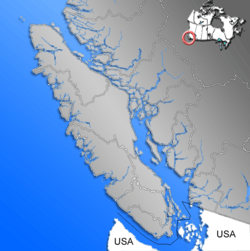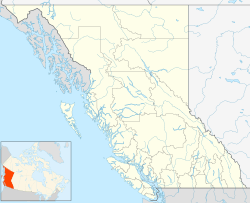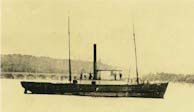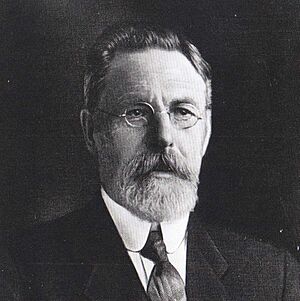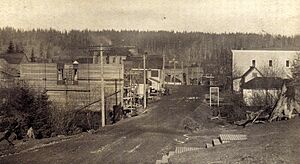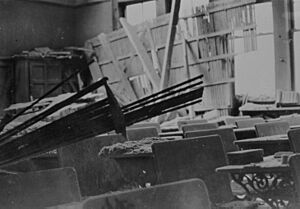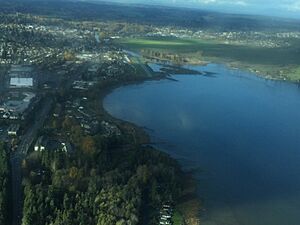Courtenay, British Columbia facts for kids
Quick facts for kids
Courtenay
|
|
|---|---|
| The Corporation of the City of Courtenay | |
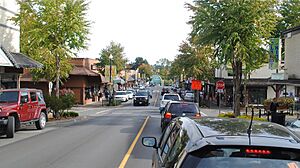
Downtown Courtenay
|
|
| Country | Canada |
| Province | British Columbia |
| Region | Mid-Island |
| Regional District | Comox Valley |
| Incorporated | 1969 |
| Area | |
| • Land | 32.41 km2 (12.51 sq mi) |
| • Metro | 596.00 km2 (230.12 sq mi) |
| Elevation | 13 m (43 ft) |
| Population
(2016)
|
|
| • City | 27,669 |
| • Density | 789.9/km2 (2,046/sq mi) |
| • Metro | 63,282 |
| • Metro density | 90.9/km2 (235/sq mi) |
| Time zone | UTC−08:00 (PST) |
| Forward sortation area |
V9J, V9N
|
| Area code(s) | 250, 778, 236, 672 |
Courtenay is a city of about 26,000 people. It is located on the east coast of Vancouver Island in British Columbia, Canada. Courtenay is the biggest community in the area known as the Comox Valley. It is also the main city for the Comox Valley Regional District.
Courtenay is close to other towns. It is 4 km west of Comox. It is 7 km northeast of Cumberland. Nanaimo is 108 km to the northwest. Courtenay is served by the Island Highway and a local airport in Comox.
Contents
Discovering Courtenay's Past
Early History of the Comox Valley
For at least 4,000 years, the Coast Salish lived here. They had a busy fishing village on the Courtenay River. The area was called kw'umuxws, meaning "plentiful." This name later became "Comox."
The Pentlatch Nation lived near Comox Bay. They spoke a dialect of the Comox Coast Salish language. Another group, the K'ómoks, lived further north.
The Pentlatch people were clever fishers. They used special fishing weirs. These were nets tied to wooden stakes. At high tide, the nets were covered. At low tide, trapped fish could be collected. You can still see these wooden stakes today. Scientists think these weirs could feed thousands of people. The Pentlatch also gathered lots of shellfish.
In the 1800s, the K'ómoks moved south. They joined the Pentlatch against a common enemy. In 1862, a terrible smallpox epidemic hit Vancouver Island. It killed many First Nations people. By 1876, only a few K'ómoks and Pentlatch remained.
European settlers arrived in 1872. By 1876, the K'ómoks and Pentlatch moved to two reserves. One was near Comox, the other near Courtenay.
First European Explorers in the Area
In 1579, Francis Drake sailed around the world. He found a good port in North America. He called this area Nova Albion. Some historians think he landed in the Courtenay River estuary.
In 1791, Spanish explorers made a map of the Strait of Georgia. They might have visited Comox Bay. The next year, Captain George Vancouver arrived. He was charting the coast for the British. He explored the Courtenay River estuary.
How Courtenay Was Settled
By the mid-1800s, more people lived on Vancouver Island. In 1837, the Hudson Bay Company looked for new trading posts. They set up a post overlooking the Courtenay River estuary. They called it "Komoux."
HMS Constance often visited the area. In 1848, sailors named the river the Courtenay River. They named it after their captain. In 1857, Captain George Richards confirmed the name.
In 1853, Sir James Douglas, the governor, saw the area's farming potential. In 1861, Lieutenant Richard Mayne agreed. He said the land was great for farming. Governor Douglas offered land for $1 per acre. He also offered free travel to the area.
The first official settlers arrived in 1862. They came on HMS Grappler. Most settlers started farms on the flat land east of the river. A small village grew there. The Courtenay Hotel was the main spot. But this area often flooded.
In 1864, Robert Brown found coal nearby. In 1874, Joseph McPhee built a bridge. It connected the flooded east side to higher ground on the west. McPhee and Reginald Pidcock bought land on the west side. McPhee built a store. Pidcock built a saw mill.
In 1888, Robert Dunsmuir opened a mine in Union (now Cumberland). This brought many new people. McPhee and Pidcock saw a chance for a new town. They divided their land into lots. The new town, "New Courtenay," grew fast. Many businesses moved to what is now 5th Street.
Courtenay in the Early 1900s
The Comox Co-operative Creamery opened in 1901. This helped dairy farms grow. At first, Courtenay had no roads to other parts of the island. News came by boat. In 1905, Joseph McPhee brought telephone service. This connected the community to the outside world. A road to Nanaimo and Victoria was built in 1910. The E&N Railway arrived in 1914.
Electricity came in 1914. Joseph McPhee wanted electricity to be public. Courtenay became a town on January 1, 1915, to help this happen. McPhee lost the mayor election. But his allies won council seats. In 1916, the town bought the electric company. It became a public service.
In 1915, a big fire destroyed part of 5th Street. Another fire hit later. People fought the fires with bucket brigades. Joseph McPhee pushed for a water system. It was installed by 1921.
In 1921, a new group called the Native Sons of Canada formed. Joseph McPhee was president. They built a large log hall in 1928. It was the biggest log building in Canada.
In 1923, a steel bridge replaced McPhee's old wooden one. Courtenay grew steadily. The population went from 600 in 1914 to 1700 in 1941. By 1951, it was 2500. Courtenay became a city in 1953. In 1960, the 5th Street bridge was replaced again. Concrete sidewalks and a sewer system were added in 1962.
In 1975, the Driftwood Mall was built. A second bridge, the 17th Street lift bridge, opened. This shifted the main business area from 5th Street to Cliffe Avenue.
The 1946 Earthquake
On June 14, 1946, a strong earthquake hit. It was a 7.3 magnitude earthquake. The center was west of Courtenay, at Forbidden Plateau. The earthquake was felt far away. Many chimneys in town were destroyed. The post office and Courtenay Elementary School were also damaged. This was the biggest earthquake on Vancouver Island. Only two deaths were reported.
Courtenay's Location and Weather
Where is Courtenay?
Courtenay is on the British Columbia Coast. It sits on the Strait of Georgia. The city has a total land area of about 26.68 square kilometers.
Courtenay's Climate
Courtenay has a mild, wet climate. It is similar to other places on eastern Vancouver Island. This is called an Oceanic climate. In spring and fall, it is cool and wet. Winters are very mild, among the mildest in Canada.
The area gets a lot of rain. This is because of the ocean and the nearby Insular Mountains. The mountains cause a "rain shadow" effect. Sometimes, cold "Arctic air" can bring freezing temperatures and snow in winter.
| Climate data for Comox Airport | |||||||||||||
|---|---|---|---|---|---|---|---|---|---|---|---|---|---|
| Month | Jan | Feb | Mar | Apr | May | Jun | Jul | Aug | Sep | Oct | Nov | Dec | Year |
| Record high humidex | 16.2 | 15.8 | 18.7 | 26.2 | 31.6 | 37.3 | 40.4 | 40.3 | 31.8 | 26.0 | 20.9 | 17.5 | 40.4 |
| Record high °C (°F) | 16.7 (62.1) |
16.3 (61.3) |
19.0 (66.2) |
26.8 (80.2) |
31.7 (89.1) |
38.0 (100.4) |
35.2 (95.4) |
33.6 (92.5) |
30.6 (87.1) |
22.9 (73.2) |
17.8 (64.0) |
17.4 (63.3) |
38.0 (100.4) |
| Mean daily maximum °C (°F) | 6.4 (43.5) |
7.4 (45.3) |
9.6 (49.3) |
12.9 (55.2) |
16.6 (61.9) |
19.8 (67.6) |
22.8 (73.0) |
22.7 (72.9) |
19.0 (66.2) |
12.9 (55.2) |
8.5 (47.3) |
5.9 (42.6) |
13.7 (56.7) |
| Daily mean °C (°F) | 3.9 (39.0) |
4.3 (39.7) |
6.1 (43.0) |
8.8 (47.8) |
12.4 (54.3) |
15.5 (59.9) |
18.0 (64.4) |
17.9 (64.2) |
14.5 (58.1) |
9.5 (49.1) |
5.7 (42.3) |
3.5 (38.3) |
10.0 (50.0) |
| Mean daily minimum °C (°F) | 1.4 (34.5) |
1.2 (34.2) |
2.5 (36.5) |
4.6 (40.3) |
8.0 (46.4) |
11.1 (52.0) |
13.3 (55.9) |
13.0 (55.4) |
9.9 (49.8) |
6.0 (42.8) |
2.9 (37.2) |
0.9 (33.6) |
6.2 (43.2) |
| Record low °C (°F) | −21.1 (−6.0) |
−16.1 (3.0) |
−13.9 (7.0) |
−4.4 (24.1) |
−2.8 (27.0) |
0.5 (32.9) |
5.0 (41.0) |
3.3 (37.9) |
−1.7 (28.9) |
−4.8 (23.4) |
−13.3 (8.1) |
−15 (5) |
−21.1 (−6.0) |
| Record low wind chill | −19 | −22 | −16 | −6 | −2 | 0 | 0 | 0 | −3 | −10 | −20 | −25 | −25 |
| Average precipitation mm (inches) | 171.9 (6.77) |
114.3 (4.50) |
105.7 (4.16) |
64.6 (2.54) |
45.6 (1.80) |
42.8 (1.69) |
26.7 (1.05) |
29.2 (1.15) |
41.8 (1.65) |
122.8 (4.83) |
200.5 (7.89) |
187.9 (7.40) |
1,153.6 (45.42) |
| Average rainfall mm (inches) | 159.1 (6.26) |
107.8 (4.24) |
95.7 (3.77) |
64.4 (2.54) |
45.6 (1.80) |
42.8 (1.69) |
26.7 (1.05) |
29.2 (1.15) |
41.8 (1.65) |
122.7 (4.83) |
191.9 (7.56) |
168.9 (6.65) |
1,096.5 (43.17) |
| Average snowfall cm (inches) | 11.9 (4.7) |
6.0 (2.4) |
9.9 (3.9) |
0.2 (0.1) |
0.0 (0.0) |
0.0 (0.0) |
0.0 (0.0) |
0.0 (0.0) |
0.0 (0.0) |
0.1 (0.0) |
8.2 (3.2) |
18.7 (7.4) |
55.0 (21.7) |
| Average precipitation days (≥ 0.2 mm) | 19.9 | 16.1 | 16.9 | 14.3 | 12.8 | 11.0 | 7.9 | 7.2 | 9.2 | 16.6 | 20.1 | 20.5 | 172.6 |
| Average rainy days (≥ 0.2 mm) | 19.0 | 15.3 | 16.4 | 14.3 | 12.8 | 11.0 | 7.9 | 7.2 | 9.2 | 16.6 | 19.7 | 19.5 | 168.9 |
| Average snowy days (≥ 0.2 cm) | 2.7 | 2.1 | 1.8 | 0.2 | 0.0 | 0.0 | 0.0 | 0.0 | 0.0 | 0.1 | 1.2 | 3.0 | 11.1 |
| Average relative humidity (%) | 83.8 | 76.5 | 70.4 | 63.8 | 61.5 | 60.2 | 57.3 | 57.6 | 62.8 | 75.8 | 81.3 | 83.4 | 69.5 |
| Source: Environment Canada | |||||||||||||
People and Economy of Courtenay
Who Lives in Courtenay?
In 2021, Courtenay had 28,420 people. This was a growth from 25,639 people in 2016. The city has many different types of households. Some are couples with children, others are single people. The average household has about 2.2 people.
The median age in Courtenay is 43 years old. This is a bit older than the average for British Columbia.
How Courtenay Makes Money
Courtenay's economy used to depend on natural resources. These included coal mining, logging, fishing, and farming. As these industries changed, Courtenay focused on services.
Now, the city serves many retired people and military families. CFB Comox is a large employer. It provides about 1,400 jobs. Tourism is also very important. It brings many visitors to the Comox Valley.
Other big employers include St. Joseph's General Hospital. Also, Mount Washington ski resort, Crown Isle Golf Course, and local hotels. These places provide many jobs.
People in the Comox Valley spend a lot on shopping. Most of this money goes to supermarkets, gas stations, and car sales. The average household income is about $59,136. Most of this income comes from jobs. Some also comes from pensions and investments.
Fun Things to Do in Courtenay
Arts and Culture Scene
Every summer, the Island Music Fest takes place. It is the biggest music festival on Vancouver Island. People camp and enjoy different kinds of music. Other festivals include the North Island Festival of Performing Arts.
Courtenay is home to the Comox Valley Youth Music Centre. It started as a two-week summer camp. Now it is a six-week program. Famous musicians like Diana Krall and Ingrid Jensen have been involved.
The Sid Williams Theatre is the main performance place. It is in downtown Courtenay. Other theaters include the Stan Hagen Theatre. You can also see plays by groups like the Rainbow Youth Theatre.
The Vancouver Island Regional Library has a branch in downtown Courtenay. It offers free Wi-Fi and computers.
Amazing Paleontology Discoveries
Courtenay is a great place for finding fossils. Many ancient sea creatures have been found here. The Comox Valley is even part of the Great Canadian Fossil Trail. Millions of years ago, Vancouver Island was under a warm sea. This was a perfect home for marine life.
After the dinosaurs died out, the land changed. Volcanic activity and glaciers shaped the area. This exposed the 80-million-year-old sea floor. This is why so many marine dinosaur fossils are found here. These include the Elasmosaur and the Mosasaur.
In 1988, Mike Trask found the first Elasmosaur fossil. It was on the Puntledge River banks. Scientists found a nearly complete skeleton. You can see the original bones and a model at the Courtenay & District Museum and Paleontology Center.
In 1991, Dr. Joe Zanbilowicz found a fossilized bone. Later, a nearly complete Mosasaur skeleton was found. Scientists realized it was a new type of Mosasaur. They named it Kourisodon Puntledgensis. It had two extra rows of sharp teeth.
Many other ancient animals are still being found. These include desmatochelys (sea turtles) and octopods.
Museums and Art Galleries to Explore
- The HMCS Alberni Museum and Memorial (HAMM) is in downtown Courtenay. It honors the men of HMCS Alberni. It also has exhibits about Canadian Forces history.
- The Courtenay and District Museum and Palaeontology Centre offers fossil tours. It also has historical exhibits.
- The Comox Air Force Museum and Heritage Airpark is at CFB Comox. It shows exhibits from the First World War onwards.
- The Cumberland Museum & Archives shows the history of coal mining.
- The Comox Archives and Museum explores the history of Comox.
- The Nim-Nim Interpretive Centre is north of the city. It highlights the achievements of the First Nations people.
Courtenay also has several art galleries. The I-Hos Gallery shows modern and traditional First Nations art. The Comox Valley Art Gallery and Muir Gallery are also supported by the community.
Beautiful Provincial Parks
There are many Provincial Parks nearby:
- Kin Beach Provincial Park has picnic areas and a playground. It also has a campground.
- Mitlenatch Island Nature Provincial Park is on a small island.
- Kitty Coleman Provincial Park is south of the Oyster River.
- Mount Geoffrey Regional Nature Park is on Hornby Island.
- Tribune Bay Provincial Park is also on Hornby Island.
- Fillongley Provincial Park is on the east side of Denman Island.
- Helliwell Provincial Park is on Hornby Island.
- Strathcona Provincial Park is about 32 km away.
Other Fun Attractions
- Woodhus Slough is a great spot for bird watching.
- Walking trails include Nymph Falls Regional Park and Seal Bay Regional Nature Park.
- The Courtenay Riverway Heritage Walk is also popular.
- The Kitty Coleman Woodland Gardens is a beautiful garden. It was created by hand over many years.
- Simms Millennium Park and Lewis Park are community parks. Simms Millennium Park was used as a training area during World War II.
- Mount Washington Alpine Resort is the biggest ski area on Vancouver Island. In winter, you can ski, snowboard, and more. In summer, you can mountain bike and hike.
Sports in Courtenay
The Comox Valley Glacier Kings play junior hockey. They play in the Vancouver Island Junior Hockey League. They won the league championship in 1993-94. They also won the playoffs in 1994-95. In 2009, the 2009 World U-17 Hockey Challenge held games here.
Getting Around Courtenay
Public Transportation
Courtenay uses the Comox Valley Transit System. It has 13 bus routes. These buses provide easy travel throughout the Comox Valley. You can go to Cumberland, Royston, and even connect to other transit systems. There is also a special service called handyDART for people with disabilities. In 2007, Comox Valley buses got free Wi-Fi for passengers.
Ferry Services
BC Ferries has two terminals nearby. One is in Little River, Comox. It connects Vancouver Island to Powell River. The other is in Buckley Bay. It connects Vancouver Island to Denman Island.
Airports Near Courtenay
There are four airports in the Courtenay area:
- Comox Valley Airport is used by the military and commercial airlines.
- Courtenay Airpark is a small airport in downtown Courtenay. It is for recreational flying.
- Courtenay Airpark Water Aerodrome has daily flights by West Coast Air.
- Courtenay (Smit Field) Airport is a small private airport.
Train Service
Via Rail used to run a train service. It went between Victoria and Courtenay. The Courtenay railway station is a historic building.
Highways
Highway 19A, also called the Island Highway, goes through Courtenay.
Safety and Schools in Courtenay
Emergency Services
The Royal Canadian Mounted Police (RCMP) handle police services. Their main office is in East Courtenay. It serves the whole Comox Valley. Crime Stoppers also helps with anonymous tips.
The Courtenay Fire Department provides fire services. It has 42 firefighters. They put out fires, help with car accidents, and teach fire safety.
Ambulance services are provided by British Columbia Ambulance Service.
Education in Courtenay
Courtenay has many public schools. They are part of School District 71 Comox Valley. In 2007, over 9,000 students were enrolled.
Elementary Schools
- Airport Elementary (Kindergarten to Grade 7)
- Arden Elementary (Kindergarten to Grade 5)
- Courtenay Elementary (Kindergarten to Grade 7)
- École Puntledge Park Elementary (Kindergarten to Grade 7)
- École Robb Road Elementary (Kindergarten to Grade 7)
- Huband Park Elementary (Kindergarten to Grade 7)
- Queneesh Elementary (Kindergarten to Grade 7)
- Valley View Elementary (Kindergarten to Grade 7)
Secondary Schools
- Georges P. Vanier Secondary (Grade 8-12)
- Lake Trail Secondary (Grade 6-9)
- Mark R Isfeld Secondary (Grade 8-12)
- Sandwick Alternate School
- Highland Secondary School (Grade 8-12)
Colleges and Universities
Courtenay is home to the largest North Island College Campus. It has about 1,669 students in credit classes. Many more take short courses. The campus has a cafeteria, bookstore, and library. It also has the Stan Hagen Theatre, used for community events. The college offers many programs. It is known for its nursing program and photography certificate.
Media in Courtenay
The local newspaper is the Comox Valley Record. There are two radio stations: CKLR-FM and CFCP-FM.
Famous People From Courtenay
- Fraser Cain, a publisher and podcast host.
- Kim Cattrall, an actress.
- Byron Dafoe, an NHL goalie.
- Brendan Fletcher, an actor.
- Taylor Green, a baseball player.
- Olaf Kölzig, an NHL goalie.
- Cameron Levins, an Olympian.
- Brett McLean, an NHL forward.
- Simon Nessman, a model.
- Sarah Neufeld, a musician.
- Spencer O'Brien, an Olympic snowboarder.
 |
Campbell River |  |
||
| Cumberland | Comox | |||
| Nanaimo |


